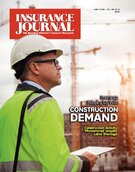In last month’s column, we began our examination of hail and windstorm claims issues by focusing on the pervasive problem of whether delayed discovery and reporting of hail damage meets the conditional requirements of most homeowners policies to report damage promptly or as soon as practicable.
In this issue, we’ll examine other hail damage issues such as actual cash value vs. replacement cost policy provisions, percentage deductibles, and special cosmetic damage exclusions, as well as existing “marring” exclusions.
Actual Cash Value vs. Replacement Cost
While this issue appears to be more pervasive in commercial lines, as opposed to personal lines policies, some carriers have introduced actual cash value (ACV) endorsements for roofs or roof coverings because of increasingly poor loss experience with wind and hailstorms, as exacerbated by the vulnerability, in particular, of asphalt shingle roofs. In some cases, these endorsements may be removed, usually for additional premium, but that may not be the case in excess and surplus (E&S) markets or other markets of last resort.
That being said, though, on this issue I’d rather focus on dispelling the all-too-common myth that a roof must be replaced within 180 days of the loss in order to receive replacement cost, rather than ACV, coverage. For example, a commercial insured (multiple condo buildings) experienced a hailstorm in May but was not aware of the damage until February when a claim was filed. The insurer admitted coverage but said only the ACV of the damage was covered because replacement cost coverage was not requested within 180 days of loss.
This is the actual governing language in the policy form [emphasis added]:
“You may make a claim for loss or damage covered by this insurance on an actual cash value basis instead of a replacement cost basis. In the event you elect to have loss or damage settled on an actual cash value basis, you may still make a claim for the additional coverage this [coverage] provides if you notify us of your intent to do so within 180 days after the loss or damage.”
For this policy provision to be correctly applied, one must follow the “RTFP!” principle and read the provision carefully. Yes, there is a 180-day (from the date of the loss) conditional requirement to get replacement cost coverage, BUT only if the insured initially “elects to have loss or damage settled on an actual cash value basis,” “instead of a replacement cost basis.”
In this case, the insured never elected ACV instead of replacement cost. He requested recovery on a replacement cost basis, as provided by the policy. Therefore, the 180-day condition is never triggered.
In addition, to dispel another myth, nothing in this language, or similar language in other policies, requires that replacement actually take place within 180 days of the loss. In some cases, such timely replacement is not possible, nor do most policies require it. The insured must simply express, within 180 days of loss, an “intent” to recover on a replacement cost basis.
Percentage Deductibles
A number of carriers have introduced windstorm or hail percentage deductible endorsements, though predominantly so far in commercial lines. These deductibles typically range from 2% to 5%. That doesn’t sound like much of a retention, but when a single multi-family apartment or condo building roof costs an average of $250,000 or more to replace following a storm that may impact multiple buildings in a complex, the result may be a very high retention. One of the primary purposes of a deductible is to encourage loss prevention by insureds, but there’s not much insureds can do about the weather other than talk about it.
Cosmetic Damage Endorsements and Marring Exclusions
Both ISO and AAIS have introduced endorsements providing an option for recovery on an ACV basis and/or an outright exclusion for “cosmetic” damage. By “cosmetic,” these forms essentially mean damage that consists only of marring, pitting or other superficial damage, but not structural damage or damage that inhibits the property from continuing to serve as a weather barrier.
Even without these endorsements, I’ve come across instances where claims were denied because damage was not structural, even though damage, as traditionally considered, means any reduction in value beyond the policy deductible.
Courts generally do not look favorably on such restrictive interpretations of “damage.” A case in point is Welton Enterprises, Inc. v. Cincinnati Ins. Co., 131 F. Supp. 3d 827, 834 (W.D. Wis. 2015) where the court found that cosmetic damage may constitute “direct physical loss” absent any more restrictive language.
In addition, some of these denials erroneously focus on “marring” exclusions but when you examine these exclusions, you typically find them within a series of exclusions that involve damage that occurs over an extended period of time, usually through normal use.
A notable contract interpretation rule is noscitur a sociis, a Latin term meaning “it is known by its associates.” Applying this principle, the meaning of an unclear or ambiguous term can be determined by considering the other terms in which it is listed. I elaborate on this and other interpretative principles in my book,
“When Words Collide: Resolving Insurance Coverage and Claims Disputes.”
But, again, it is important to read the policy carefully. For example, one proprietary dwelling policy actually defined “marring” to mean [emphasis added]:
“… any disfigurement, blemish, discoloration, weathering, or stretching, or the like … including, but not limited to, scratching, denting, creasing, gouging, fading, staining, tearing, oxidizing, blistering, or thinning, whether occurring at once or over time.”
Well, while I had originally intended to cover this topic in two articles, we’ve run out of space in this issue and there are still important considerations such as matching issues, Pair Or Set clauses, suits against the insurer, and potential solutions to all of these issues. So, tune in next month to Part 3 of this series.
Topics Claims
Was this article valuable?
Here are more articles you may enjoy.



 As Rates Rise, Majority of Homeowners Say Insurance Industry Is in Crisis: Survey
As Rates Rise, Majority of Homeowners Say Insurance Industry Is in Crisis: Survey  Zurich to Buy AIG’s Travel Insurance Business for $600 Million
Zurich to Buy AIG’s Travel Insurance Business for $600 Million  QBE to Non-Renew $500M of North American Mid-Market Biz
QBE to Non-Renew $500M of North American Mid-Market Biz  Allstate, Nationwide Post Dramatic Q12024 Homeowners Loss Ratio Drops: S&P
Allstate, Nationwide Post Dramatic Q12024 Homeowners Loss Ratio Drops: S&P 



